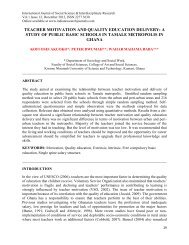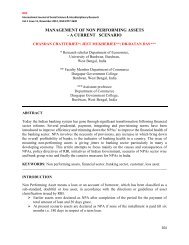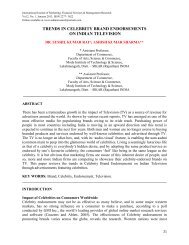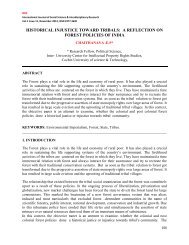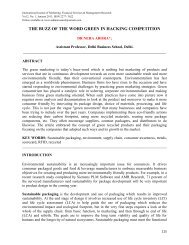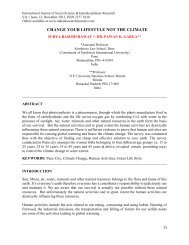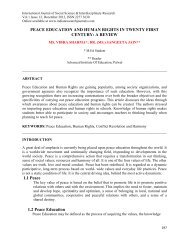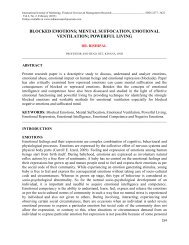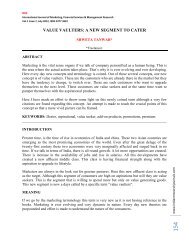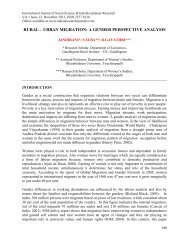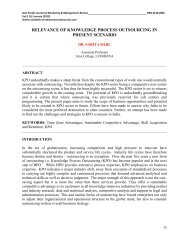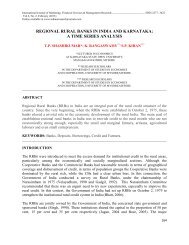problems and prospects of small scale industrial units
problems and prospects of small scale industrial units
problems and prospects of small scale industrial units
Create successful ePaper yourself
Turn your PDF publications into a flip-book with our unique Google optimized e-Paper software.
IRJC<br />
Asia Pacific Journal <strong>of</strong> Marketing & Management Review<br />
Vol.1 No. 2, October 2012, ISSN 2319-2836<br />
ROLE OF GOVERNMENT<br />
Small enterprises assume special position in India because <strong>of</strong> their role as creators <strong>of</strong><br />
large <strong>scale</strong> employment opportunities apart from contributing significantly to <strong>industrial</strong><br />
production, exports <strong>and</strong> regional dispersal. In the next 9-10 years, there may not be drastic<br />
changes in the structure <strong>of</strong> SSIs but some changes may be expected in the composition <strong>of</strong> the SSI<br />
sector in India. In the changed environment only the efficient, viable <strong>and</strong> competitive SSI <strong>units</strong><br />
will survive. The contribution <strong>of</strong> this sector which is currently 40percent <strong>of</strong> <strong>industrial</strong> production<br />
<strong>and</strong> 35percent <strong>of</strong> exports, will further improve. The SSI sector currently provides employment to<br />
192 lacs persons. According to Working Group on 10 th Plan on SSIs, 44.1 lacs additional<br />
employment opportunities would be provided by the end <strong>of</strong> 10 th Plan. This has also been<br />
accepted by Dr. S.P. Gupta Special Group Report (May 2002) on Targeting 10 Million jobs per<br />
year during 10 th Five Year Plan. At present our share in the world trade is only 0.67percent,<br />
which is very low by any st<strong>and</strong>ards. This will have to be improved to 1.5percent in the next 10<br />
years. The target by the end <strong>of</strong> 10 th Plan is to raise share to 1percent. The SSI sector is expected<br />
to be contributing significantly to our national exports; may be to the tune <strong>of</strong> 50percent. For this,<br />
the sector will need certain support so that it is able to overcome the h<strong>and</strong>icaps due to<br />
inaccessibility to economies <strong>of</strong> <strong>scale</strong> <strong>and</strong> the use <strong>of</strong> somewhat obsolete technology, inadequate<br />
<strong>and</strong> delayed supply <strong>of</strong> credit, poor infrastructure etc. Though the policy <strong>of</strong> reservation in the<br />
present form may not exist but the sector will need some support which will help it to attain a<br />
level playing ground. The Comprehensive Policy Package announced by the Prime Minister on<br />
30 th August 2000 may be able to improve the situation with regard to the availability <strong>of</strong> credit<br />
<strong>and</strong> infrastructure <strong>and</strong> in technology up gradation. The role <strong>of</strong> the Government will also undergo<br />
changes from one <strong>of</strong> the protector to facilitator. In fact, during the last ten years i.e. after the<br />
introduction <strong>of</strong> economic reforms, one can discern a change in the role <strong>of</strong> the Government. In the<br />
developing countries, where the infrastructural facilities for development are inadequate <strong>and</strong><br />
entrepreneurial activities are limited, the promotional role <strong>of</strong> government assumes the special<br />
significance. The State will have to assume direct responsibility to build up <strong>and</strong> strengthen the<br />
necessary developmental guidance on promoting technologies through Tool Rooms, Process cum<br />
Product Development Centers, Testing Centers etc. The role <strong>of</strong> the Government in ensuring a<br />
level playing field to SSIs will continue <strong>and</strong> hence fiscal, monetary <strong>and</strong> other incentives will<br />
continue.<br />
The present study is an attempt in that direction with the main purpose to locate the <strong>problems</strong><br />
<strong>and</strong> practices prevalent in these industries. It is a study <strong>of</strong> <strong>problems</strong> <strong>and</strong> <strong>prospects</strong> <strong>of</strong> exporting<br />
<strong>and</strong> non-exporting <strong>small</strong> <strong>scale</strong> industries. So, it will also helpful to boost the export <strong>of</strong> country.<br />
REVIEW OF LITERATURE<br />
The review <strong>of</strong> existing literature is not customary rather an essential part <strong>of</strong> research work. It also<br />
facilitates the comparison between the earlier findings <strong>and</strong> findings <strong>of</strong> present study. Here is the<br />
brief review <strong>of</strong> some studies on the subject.<br />
Mattew, et.al (1998) delineated in his article, “Research <strong>and</strong> Development – Recent Trends” that<br />
India should deliver high quality products by use <strong>of</strong> indigenous advanced technologies.<br />
Industries should upgrade its present facilities <strong>and</strong> products to international st<strong>and</strong>ard.<br />
194<br />
www.indianresearchjournals.com



